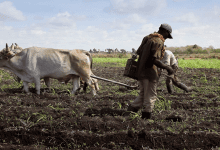Where we have gone wrong and why is it agrarian crisis keeps recurring in India. The answer is simple: Despite big strides in farming, India is yet to develop smart agriculture. While we have projects for smart cities, smart banking and so on, no attempt has been made to make farming smart using technology. Farmers’ income needs to be stepped up substantially to ensure crop failures do not hit hard and adequate money is generated for the rainy day. An analysis, for Different Truths.
Even though agriculture accounted for only 15 percent of GDP, it can make or shatter Indian economy as nearly half of the 1.3 billion population depend on farming. If Indian economy has to clock a double-digit growth on a sustained basis, the farm sector has to grow by at least 4 percent annually on a continuous basis. The best India has achieved was 3.6 percent average growth for about 6-7 years ending 2012. This is the time when the economy too was booming, growing at nearly at double-digit.
So the question is where we have gone wrong and why is it agrarian crisis keeps recurring in India. The answer is simple: Despite big strides in farming, India is yet to develop smart agriculture. While we have projects for smart cities, smart banking and so on, no attempt has been made to make farming smart using technology. Farmers’ income needs to be stepped up substantially to ensure crop failures do not hit hard and adequate money is generated for the rainy day. If farmers’ income has to rise, the dependence only on agriculture for income has to change and farmers will have to take to animal husbandry, poultry, fisheries, food processing, agri-related rural industries and so on for augmenting income. This is because farming by very nature is seasonal and hence there is already disguised unemployment even in best of times. As it depends on vagaries of weather, it makes things worse for farmers in difficult times, making farming most risky occupation.
Though India has the largest irrigated area in the world, nearly half of Indian farming is still done in rain-fed areas. As the saying goes, the next World War will be fought on water and hence water management and linking of peninsular rivers have to be given top priority so that there is more stability in farm growth, which is essential to ensure adequate food is available to the large population irrespective of crop failure in certain years. Despite farming being un-remunerative, farmers are doing yeomen service to the nation in spite of the per capita farm income in India being less than Rs 25,000 annually. Even doubling of per capita income is not adequate to make farming remunerative.
India has not done badly in agriculture in 70 years after Independence as there are no starvation deaths now, thanks to Green Revolution. Today India is the second largest in terms of farm GDP after China as it lately overtook the United States. India’s farm production is around $360 billion and has the potential to export up to $100 billion as against mere $30 billion at present as India’s farm production is the cheapest in the world and is of high quality. If Indian farming becomes smart through proper support, India can easily overtake China as well, whose farm GDP is around $ 1 trillion, as India’s farm productivity matches that of China in pockets and India has more fertile area. In China, only one-seventh of its land is cultivable as most parts of China are desert and mountainous. Gangetic plains are the richest cultivable area in the world. There are pockets in Bihar where rice yield per hectare matches that of China and yet the average rice yield in the state is one-fifth of that of China. This is a dichotomy and the same is true for all other crops in various parts of the country. The country has the highest yield per hectare in the world in pockets for most of the crops and yet average farm productivity needs to be vastly improved to realize the full farm potential.
This is one aspect of the problem, which needs to be tackled through technology and farmers’ education by strengthening the extension system that has collapsed in the last 5-10 years. Here central and state governments have a big role to play.
The second aspect is how to prevent wastage and improve marketing and better use of products for higher prices through cold storage facilities. As per a parliamentary standing committee report, there is a crop loss of Rs 90,000 crore due to non-use of pesticides, weedicides, fungicides and if calculated on the basis of MSP, the loss may be around Rs 4 lakh crore. The loss due to wastage of vegetables and fruits is around Rs 50,000 crore annually. India is the largest producer of fruits and vegetables but there is so much rotting as nearly 40 percent is lost due to lack of cold storage and food processing facilities around the place of produce. If a cluster of villages is producing high quality of tomatoes, it should be organized to join together and set up common cold storage facility like common effluent treatment plants. This will help in not only increasing the shelf life of tomatoes but also provide a better price for farmers who otherwise make distress sale. This model could be adopted for every other fruit and vegetable to prevent wastage and discover better prices and higher income for farmers.
Likewise, common godowns should be set up for other crops around the villages producing them. In this connection, encouraging FDI in multi-brand retail will help in setting up cold storage chain and procurement straight from the farm will help farmers get a better price with middlemen getting increasingly phased out. The fear that this will hit hard Kirana shops is unfounded as at 8-9 percent GDP growth, multi-brand retail will double from $700 billion to $1.4 trillion in five to seven years. This means not only multi-brand retail as well as Kirana stores will grow. Also one must know that 70 percent of sales in multi-brand retail are food products thereby helping Indian farming tremendously, apart from providing better income to farmers.
A lot of efforts too are needed in providing right quality inputs including hybrid seeds, plant protection, improving soil quality and increasing use of organic manure. All these require concerted efforts by both central and state governments, apart from a change in mindset to make farm sector smart and technology driven. Drip irrigation and judicious use of fertilizer will result in a huge saving of water and fertilizer. Their usage could be reduced by two-thirds resulting in the huge saving to farmers and national resources. This is achievable through a little tweaking of policies by government, which so far has been perceived to be inadvertently encouraging crony capitalism.
K R Sudhaman
©IPA Service
Photo from the Internet





 By
By

